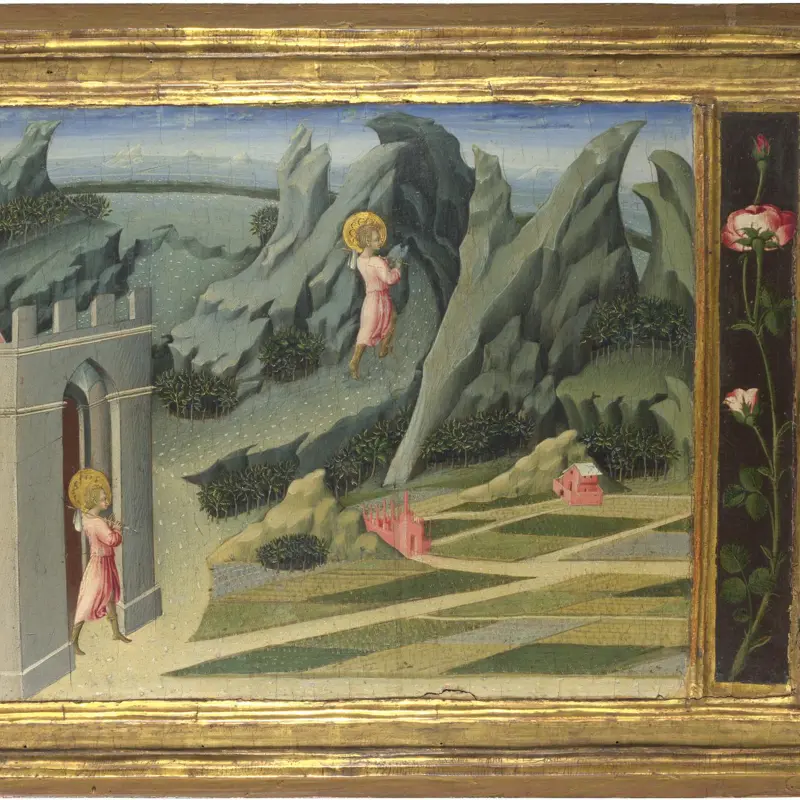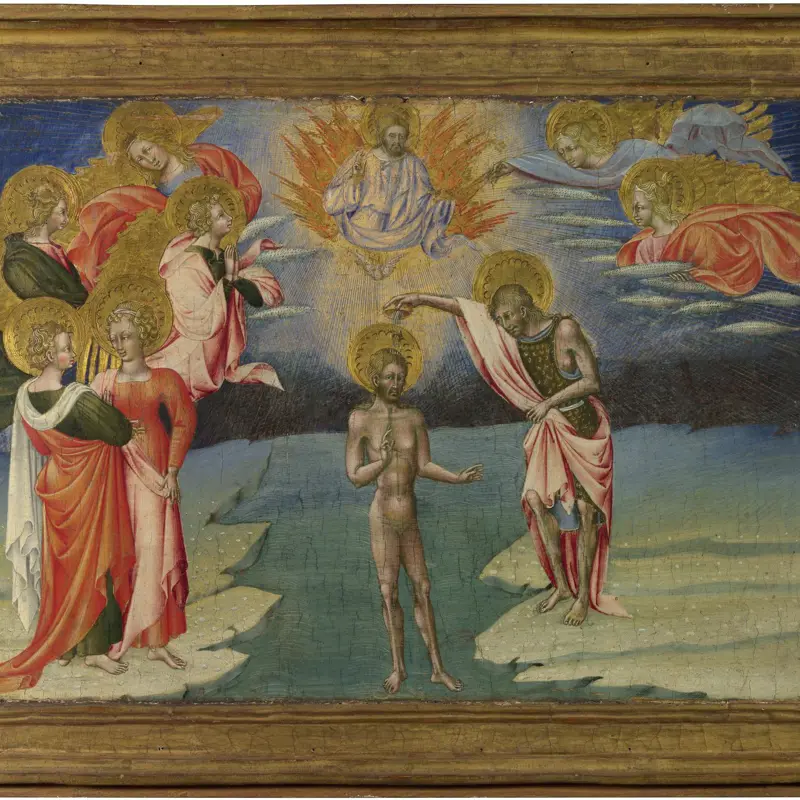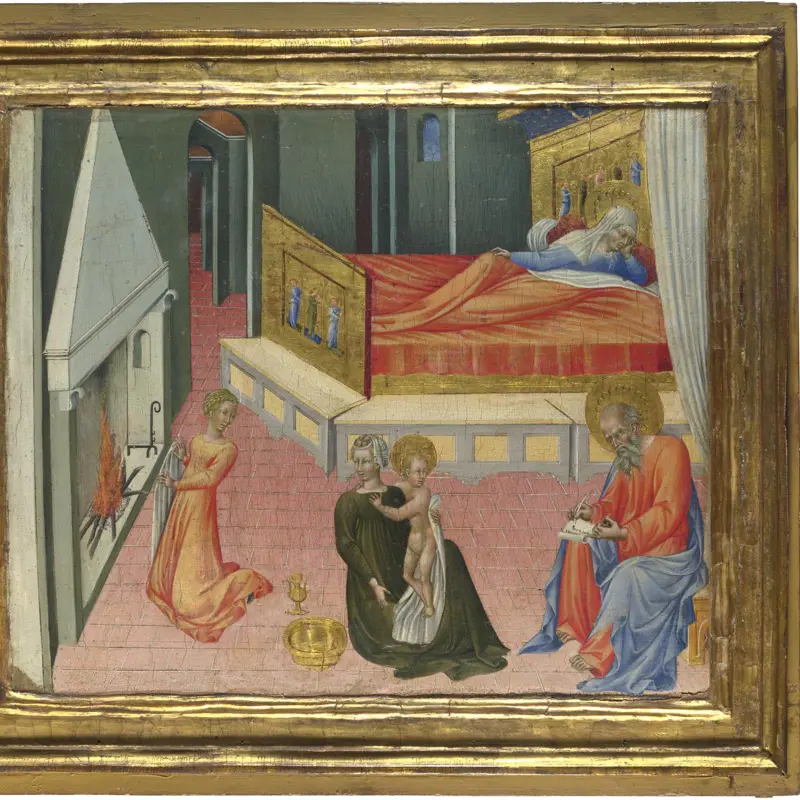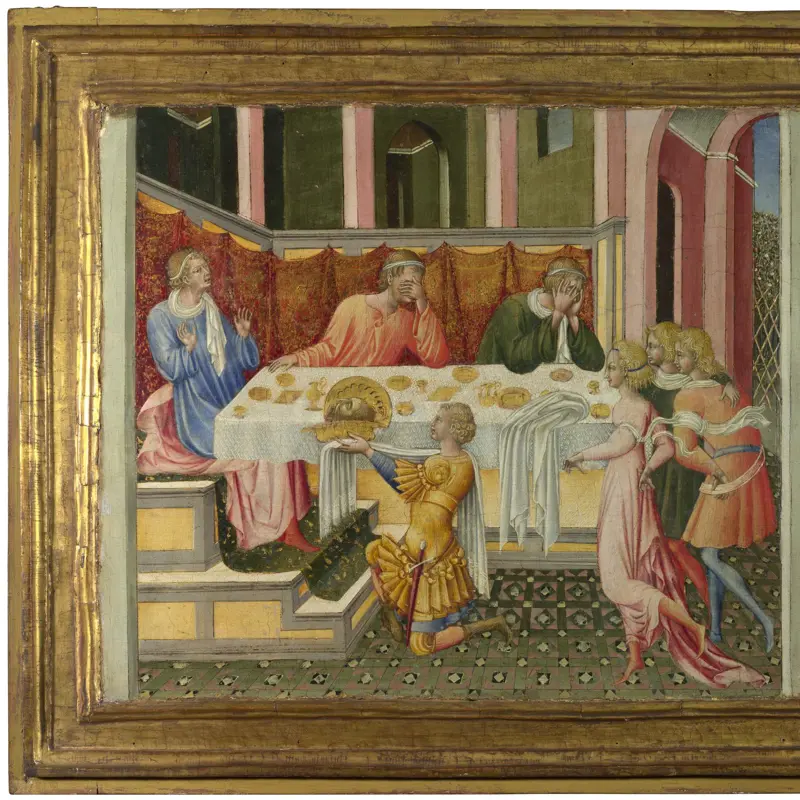Giovanni di Paolo, 'Saints Fabian and Sebastian', about 1475
About the work
Overview
Saint Fabian and Saint Sebastian, wounded by arrows, are shown together with two tiny figures wearing black cloaks with hoods and white veils. Medieval Christians prayed to both saints as protectors against the plague.
Saint Fabian was pope in the third century and is shown wearing a papal tiara; he was martyred under the Roman Emperor Decius. Sebastian was tortured by the Emperor Diocletian who ordered his soldiers to tie him to a stake and shoot him with arrows. He survived, but was later beaten to death. Thick droplets of vivid red blood ooze from each of his wounds.
This painting was made in Siena, and it’s likely that it was commissioned by the religious group to which the little kneeling figures belonged. They may represent a group called the Bianchi – who had an altar dedicated to the saints in the eighteenth century – although they usually wore all white. This large panel may have originally been painted on both sides and carried in religious processions.
Key facts
Details
- Full title
- Saints Fabian and Sebastian
- Artist
- Giovanni di Paolo
- Artist dates
- active by 1417; died 1482
- Date made
- about 1475
- Medium and support
- egg tempera on wood
- Dimensions
- 84.5 × 54.5 cm
- Acquisition credit
- Presented through the Art Fund in memory of Robert Ross, 1919
- Inventory number
- NG3402
- Location
- Room 58
- Collection
- Main Collection
- Frame
- 15th-century Sienese Frame (original frame)
Provenance
Additional information
Text extracted from the ‘Provenance’ section of the catalogue entry in Dillian Gordon, ‘National Gallery Catalogues: The Fifteenth Century Italian Paintings’, vol. 1, London 2003; for further information, see the full catalogue entry.
Bibliography
-
1915T. Borenius, 'SS. Fabian and Borenius by Giovanni di Paolo', The Burlington Magazine, XXVIII/151, 1915, pp. 2-3
-
1923R. van Marle, The Development of the Italian Schools of Painting, 19 vols, The Hague 1923
-
1925E. Hutton, The Sienese School in the National Gallery, London 1925
-
1937J. Pope-Hennessy, Giovanni di Paolo, London 1937
-
1947C. Brandi, Giovanni di Paolo, Florence 1947
-
1951Davies, Martin, National Gallery Catalogues: The Earlier Italian Schools, London 1951
-
1978D. Bomford and J. Kirby, 'Giovanni di Paolo's "SS. Fabian and Sebastian"', National Gallery Technical Bulletin, II, 1978, pp. 56-63
-
1986Davies, Martin, National Gallery Catalogues: The Earlier Italian Schools, revised edn, London 1986
-
1998E. Klein, E. Gordon and K. French, 'Stylistic, Technical and Material Developments in the Paintings of Giovanni di Paolo', in A. Roy and P. Smith (eds), Painting Techniques: History, Materials and Studio Practice: Contributions to the Dublin Congress 7-11 September 1998, London 1998, pp. 82-8
-
2001
C. Baker and T. Henry, The National Gallery: Complete Illustrated Catalogue, London 2001
-
2002D. Bomford et al., Underdrawings in Renaissance Paintings (exh. cat. The National Gallery, 30 October 2002 - 16 February 2003), London 2002
-
2003Gordon, Dillian, National Gallery Catalogues: The Fifteenth Century Italian Paintings, 1, London 2003
About this record
If you know more about this work or have spotted an error, please contact us. Please note that exhibition histories are listed from 2009 onwards. Bibliographies may not be complete; more comprehensive information is available in the National Gallery Library.




